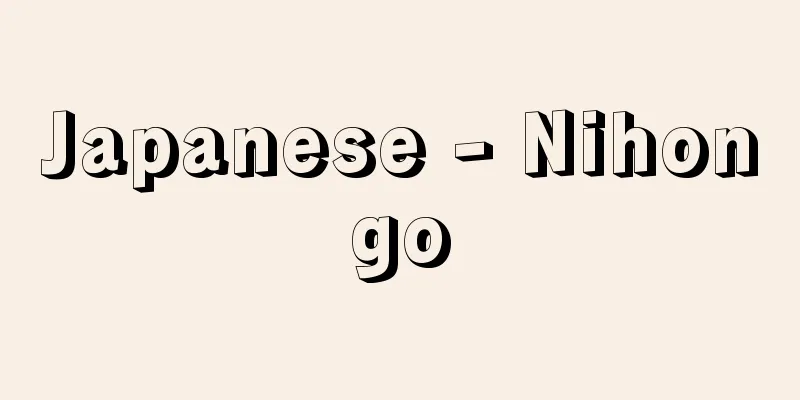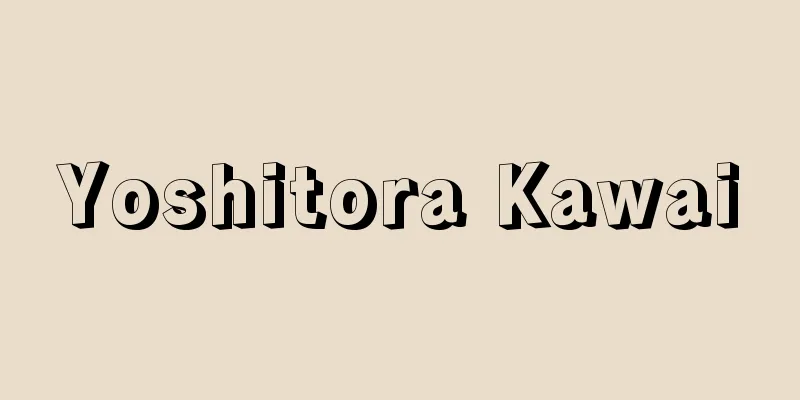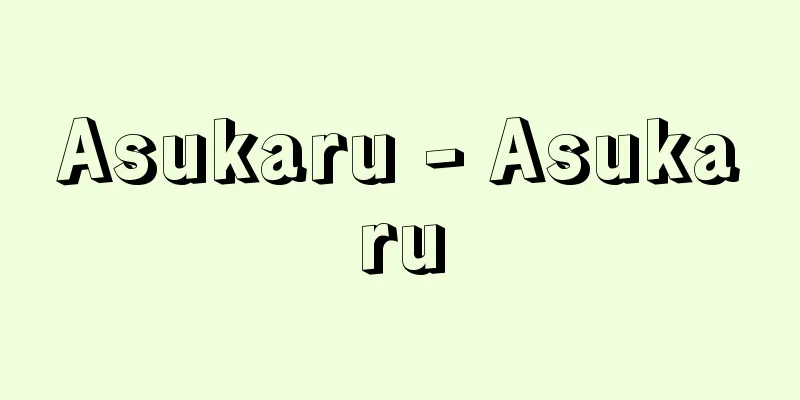Japanese - Nihongo

|
The name of a language that was used and developed mainly by the Japanese people in the Japanese archipelago. Japanese people also call it the national language. There are many theories about its lineage and origin, including that it is a northern language of the Uralo-Altaic family, that it is a southern language of the Malayo-Polynesian family, that it is a mixture of the two, and that it originated from English, Persian, or Indian languages, but none of them have been agreed upon by the academic community. Due to the lack of materials on ancient languages of neighboring languages, progress in research on this aspect will be very difficult. [Yutaka Tsukishima] distributionIt is widely spoken throughout the entire territory of Japan, including Honshu, Shikoku, Kyushu, Hokkaido, Okinawa and its islands, and does not compete with other languages. However, from the end of the Meiji period to the end of World War II, there was a period when Japanese language education was provided to the entire population of Taiwan, Karafuto (Sakhalin), and the Korean Peninsula. It is also spoken among Japanese who have emigrated overseas, but it is thought that it is rarely passed on to third-generation or younger generations. Furthermore, education and dissemination of Japanese to foreigners is poor. As of 1998, the Japanese language population is approximately 125 million, and it is counted alongside English, Chinese, Russian, and Spanish as one of the world's major languages, but it is not necessarily international in nature, and future measures are required. [Yutaka Tsukishima] Common language and dialectsThere is no official authority that sets standards for the Japanese language, but the National Language Council (under the jurisdiction of the Agency for Cultural Affairs) deliberates and submits recommendations on modern colloquial Japanese, and based on these, Cabinet orders and notices are issued, so that the writing of official documents is generally unified. This also relates to the law on naming people. Meanwhile, elementary, middle, and high school textbooks are inspected by the Ministry of Education (now the Ministry of Education, Culture, Sports, Science and Technology), and are subject to the same regulations. Many newspapers and magazines also use this as a standard, so it can be said that the writing form of modern Japanese is generally unified. In addition, with the spread of radio and television, a common language (standard language) based on the language of the Tokyo middle class has spread throughout the country for spoken language (oral language). Dialects are divided throughout the country, but they are divided into two major categories: mainland dialects and Ryukyu dialects, and the mainland dialects are further divided into three: eastern Japan dialects, western Japan dialects, and Kyushu dialects. There are rules for phonetic (including accent) correspondence between the two, and the rules also clearly correspond to each other in grammar. Vocabulary shows many individual differences from region to region, and among them, there are many examples of words that were used in the central area in ancient, medieval, and early modern periods, but have fallen out of use today, remaining in local areas. This type of phenomenon is often seen not only in vocabulary, but also in phonetics and grammar. The history of Japanese dialects is not very clear due to a lack of documents. However, in the 8th century, there was a dialect in the eastern part of Japan (roughly east of present-day Shizuoka Prefecture) that was different from the Yamato (Nara Prefecture) region where the capital was located at the time, and it seems that there were significant differences in phonology, grammar, vocabulary, etc. Later, it is known that the dialects of the eastern part of Japan and Kyushu were in conflict with the language of the central government (Kyoto) around the end of the 16th century, but the events of the several hundred years in between are almost unknown. During the Edo period, the feudal system developed, and lords were appointed to various regions. Furthermore, there was exchange between the central government (Edo) and the sankin-kotai system and other exchanges, so there were many opportunities to compare and observe dialects of various regions. It is assumed that various dialects like those of today already existed at that time. Dialects are closely related to the speaker's sense of home and the structure of the local community, and there are problems such as dialect complexes, but in the future, it is thought that there will be many problems to deal with, involving various factors such as the spread of a common language and the promotion of the uniqueness of local communities. [Yutaka Tsukishima] Relationship with other languagesHistorically, Japanese has not experienced any serious conflicts in its interactions with other languages. Because the Japanese archipelago was geographically isolated from the continent, it was rarely politically invaded, and as a result, the Japanese language was never forcibly banned or suppressed. Therefore, since historical times, Japanese has mainly undergone changes within itself, and the influence of other languages has been limited to a certain degree to vocabulary, and there has been some influence on phonology, but in terms of grammar and other aspects, many of the characteristics of the ancient language have not been lost and have remained to the present day. On the other hand, Japanese culture as a whole looked to China in ancient times and to Europe and America in modern times, and has endeavored to import and absorb cultural phenomena in many areas. In response to this, in terms of language, many words have been borrowed from Chinese in ancient times and from English and other European languages more recently, and in terms of phonology, there are some points of influence from these foreign languages, but there is no significant influence in grammar. In the north, there has been contact with the Ainu people since ancient times, and some Ainu words such as konbu (kelp) and rakko (tiger hunter) have entered Japanese, but conversely, it is said that there are many words that have entered Ainu language from Japanese, and the mutual genealogical relationship has not yet been fully elucidated. It is also thought that there has been contact with the languages of the Korean Peninsula since ancient times, and many theories have been proposed in the past that they are of the same lineage. It is true that there are many common points that can be recognized in terms of grammatical structure and phonological system, but the examples of correspondence in vocabulary are too few, and the current theory that is insufficient to prove a common lineage is prevalent. Compared to these, the influence of Chinese is probably the greatest. This is because Japan has looked up to China as the source of its culture for over a thousand years. It seems that a considerable number of Chinese words (kango) had already been borrowed as early as the 8th century, and by the 10th century, it had extended to terms related to Buddhism, imported furnishings, nouns expressing abstract concepts such as "kesou" (to think), "ge" (to suit), and "gusu" (to furnish), as well as adverbs and verbs. Even more Chinese words were used when reading Chinese classics or composing Chinese poetry, but as the influence of Chinese classics grew stronger in both spoken and written language from the Middle Ages onwards, the weight of Chinese words increased even more. Furthermore, with the new import of Zen Buddhism from China, Chinese words (tang ongoing) with the pronunciation of the new era flowed in. Portuguese, Dutch and other Western languages were introduced during the Christian period at the end of the Middle Ages and the development of Western studies from the mid-Edo period onwards, but in addition to being introduced in their original form, many were translated into Chinese, a tendency that was particularly noticeable after the Meiji period. After the Second World War, the influence of American culture led to a marked increase in borrowings, primarily from English, but these borrowings were characterized by the fact that they were left in their original form, including not only nouns but also verbs and adjectival verbs such as "start" and "delicate." However, the rule is that foreign words are treated as nouns, and this can be seen as maintaining the grammatical character of Japanese since the ancient borrowing of Chinese words. [Yutaka Tsukishima] phaseThe diversity of linguistic phases is one of the characteristics of the Japanese language. Today, the difference between written and spoken language is small, but there is still a slight gap in terms of vocabulary and grammar. Until some time ago, the formal written language used terms that were significantly different from spoken language, and was called the literary style, which was based on Japanese language from around the 10th century AD and was traditionally used for about 1,000 years after that. In contrast to this literary style, the colloquial style is based on modern language and has its own separate systems of literary grammar and colloquial grammar. Within the literary style, there are further types such as Japanese style, Chinese reading style, Japanese-Chinese mixed style, and epistolary style, and they have been used differently depending on the situation. In addition, Chinese literature and Chinese poetry were mainly used by scholars and monks. This was originally a foreign language text, but it was often used by those classes since ancient times as an expression of academic writing and culture. On the other hand, even within colloquial language, there are considerable differences between conversation and writing, and in conversational language, honorific language is used or not depending on the relationship between the speaker and the listener. Within written language, there is a distinction between plain style (dearu style) and polite style (desu style), but this is not related to the relationship with the reader, but is used depending on the genre of the text, such as an essay or literary work, and plain style is generally used. In terms of class and occupation differences, it seems that from ancient times to modern times, there were various class and occupational terms in each era. In the Middle Ages and Middle Ages, there were special terms used by people involved in the rituals at Ise Shrine and other places, and special words used mainly by court ladies. In particular, in the early modern period, with the establishment of a feudal social system, social discrimination between samurai, farmers, artisans, and merchants became strong, and it seems that a clear difference arose between the language of the samurai class and the language of farmers. In addition, it is said that there was a unique language used only in pleasure quarters. After the Meiji period, such class discrimination was abolished for the time being, but there still remained some differences between government officials and military personnel and merchants and craftsmen. However, this rapidly decreased with the social changes after World War II, and it can be said that the differences in language based on society and occupation have gradually become smaller and are moving in the direction of uniformity overall. [Yutaka Tsukishima] phonemeThe standard phonological system of Japanese can be roughly organized as follows: Speech (sentences) are analyzed into phrases based on the breaks in breath, which are further divided into syllables, and syllables are further divided into single sounds. Single sounds include consonants and vowels, and among the consonants, j (y) and w have properties similar to vowels and are also called semivowels. The unit of syllable is important in Japanese, and this has been strongly recognized since ancient times, with both hiragana and katakana being created using this unit. shows Japanese syllables in katakana and roman letters (phonetic symbols). Among these, there are those that are only used for Chinese character sounds, those that are only used for foreign words, those that are only used with ku, such as mya, in the form "myaku", and others that have a limited range of use. The characteristic of Japanese being dominated by open syllables (syllables ending in a vowel) exists across all dialects of Japanese, and this characteristic has not changed significantly since recorded history. Exceptions include the spastic consonant (n) and the short consonant (tsu) (written /N/ and /ʔ/, respectively, in phonology), but both of these are new and only emerged after the 9th century, and these, along with the long consonants (kya, shu, cho, etc.), are thought to be the result of the influence of Chinese sounds. It is generally believed that up until the 8th century, Japanese had eight different vowels, three more than the current number (although in recent times there are theoretically views that deny this), and in the old days, two different vowels were used for each of the 13 kana syllabaries: ki, ke, ko, so, to, no, hi, he, mi, me, mo, yo, and ro, depending on the word. From the latter half of the 8th century, this distinction began to disappear, and it is believed that by the middle of the 9th century, it had become the same as it is today. In the old days, there was also a distinction between e in the a-row and e je (ye) in the ya-row, but by the middle of the 10th century, this was unified into je. There is also a theory that the ha-row sounds were pa, pi, pu, pe, and po in the old days, but this is an assumption based on the pronunciation and other factors that remain in some parts of the Ryukyu dialect, and is not certain. It is said that by the 8th century, it had become a consonant Φ (F). From the end of the 10th century, Φ also changed to w in the middle and end of words, and Φ only remained at the beginning of a few words, but after the 17th century, it changed to h except for Φu. There are many unknowns about the consonants of the sa row, but it is said that sa was tsa and so was tso. The ta row consonants are thought to have been ta, ti, tu, te, and to in ancient times. The phonetic values of the other syllables seem to have been the same as they are today, or similar, since ancient times. Around the end of the 16th century, p came into existence and sometimes occurred after a geminated consonant. Since the end of the Middle Ages, loanwords from European languages have been used, and syllables such as mu, si, she, ti, fa, fi, fe, va, and ve have been used among them. Ti and fa are sounds that were in the Japanese language long ago, and filled the gaps that were left when ti > tʃi and Φa > ha were later changed. Consonants include k, g, s, ʃ, z, ʒ, t, tʃ, ts, d, dz, dʒ, n, h, ç, Φ, b, p, m, j, r, and w, of which j and w are also called semivowels. There are five standard vowels: a, i, u, e, and o, but there is a distinction between the sound of u, such as ɯ in the Tokyo dialect and u in the Kansai dialect, and there are some dialects that do not distinguish between i and u, and dialects such as the Ryukyu dialect that only have three sounds, a, i, and u. However, the predominance of open syllables is a feature that is generally consistent across dialects. The accent is a so-called pitch accent, which has a relative pitch for each syllable. It is roughly divided into three types: Kansai style, Kanto style, and type 1, and the so-called "law of correspondence of patterns" can be found among the various dialects. This law has been proven to exist not only in modern languages, but also in the Kyoto dialect in the modern era, the early modern period, and the late Heian period. The history of Japanese accent is systematically known up until the end of the Heian period (around the 12th century), but the situation before that is only fragmentarily known. The state of change after the Middle Ages is also not necessarily clear, but there are materials that provide a system from the early modern period. However, all of these are systems of the Kyoto dialect, and there are various theories about the historical relationship between the three major divisions that exist in modern dialects, but no consensus has yet been reached. [Yutaka Tsukishima] characterThere are three types of characters used in modern Japanese: kanji, hiragana, and katakana, but of these, kanji and hiragana are primarily used, with katakana playing a supporting role. In addition, Roman letters and Greek letters are sometimes used, but only in special cases. The above-mentioned usage has existed since World War II; before that, official documents such as constitutions and laws were often written in a mixture of kanji and katakana. Until the Edo period, documents written entirely in kanji were much more common. Originally, Japan did not have its own original characters, and the theory that there were unique characters from ancient Japan, called Jindai characters or the like, is a fabrication made up by people in later generations. It is believed that the Japanese first became aware of writing when Chinese characters were introduced from the continent. Although it is unclear when this occurred, by the beginning of the 5th century, Chinese characters were already being used in Japan to compose sentences and to write Japanese phonetically. Hiragana and katakana were created by simplifying the characters or omitting some of the strokes based on the phonetic use of Chinese characters (Man'yōgana), and were used by scribes at the Japanese imperial court and Buddhist monks at temples since the beginning of the 9th century. Hiragana was fully completed by the end of the 10th century, and later became more complex with the addition of artistic elements such as calligraphy, but katakana was developed purely for practical purposes and was mostly completed by the 12th century. Hiragana was used independently from the beginning or in combination with Chinese characters, while katakana was initially used mainly as an auxiliary mark for writing Chinese reading marks. On the other hand, it was also used in conjunction with kanji from early on, and as this usage became more widespread, katakana also began to be used independently. Generally, hiragana was used in literary works and for women and children, while katakana was used by men such as scholars and monks who mainly studied Chinese classics. The Iroha Song was used as a kana alphabet table. It was written mainly in hiragana and consisted of 47 characters: "Iroha ni ho e to chirinuru wo waka yo tare sotsune naramu ui no oku yama ke fu koete asaki yume mishi e hi mo sesu" (sometimes "n" or "kyo" was added at the end). It is said to be based on the words of a Buddhist scripture that describes the impermanence of all things, and was widely believed to have been written by Kobo Daishi Kukai (774-835). However, this song was probably created after the mid-10th century, so it is hard to believe that it was written by Kukai. Historical kana spelling was also determined based on the characters found in this song, and was previously widely used for word order in dictionaries and other purposes, but since the two characters "wi" and "we" have disappeared from the "Modern Kana Usage," many people do not know this today. On the other hand, the Japanese Alphabet Chart (Aiueo) was originally a chart devised in the world of phonology, but later came to be considered as a alphabet chart, and since the 1920s has been widely used not only for the word order in dictionaries, but also for displaying order and enumeration. The theory that it was created by Kibi no Makibi (693-775) is a myth, and it would be more appropriate to assume that it was created by a Buddhist monk around the end of the 10th century. Roman letters were introduced from Europe at the end of the Middle Ages, and at one time publications were made using movable type printing, but this was lost due to the suppression of Christianity. However, following negotiations with the Netherlands and other Western countries, Western studies such as Rangaku emerged from around the early modern period, and Roman letters were used within these studies, but only among a small number of scholars. After the Meiji period, exchanges with Europe and America became more active, and the study of foreign languages became widespread, leading to a movement to write Japanese in Roman letters instead of kanji and kana. Since the early Meiji period, there have been movements such as the Kanamojikai, which sought to abolish kanji and write the national language using only hiragana or katakana, and these and the series of national letter reform movements have continued continuously since then. The "Tōyō Kanji" (Corresponding Kanji) issued in 1946 (Showa 21) limited the number of kanji to 1,850, and was seen as the first step in the reform movement, but it faced strong opposition from various quarters, and in 1981 the number of "jōyō kanji" was increased to 1,945, and the policy of regulation was greatly relaxed. In the revision in 2010 (Heisei 22), 196 kanji were added and 5 were deleted, bringing the number of jōyō kanji to 2,136. It is said that the reform after World War II was also forced by the occupation policy of the US military at the time, and although there was the drawback of dealing with this issue, which is deeply related to the vocabulary system and style of Japanese, in a uniform and superficial manner, it is certain that this kanji restriction simplified and simplified Japanese expressions. On the other hand, it cannot be denied that there were negative aspects, such as making it difficult to pass on the cultural heritage of the previous era and reducing the richness of subtle expressions. As mentioned above, Chinese characters have been the main way of writing Japanese for many years. In the process, many unique Japanese usages that did not exist in China developed. First, the pronunciation of Chinese characters was established based on the original pronunciation of the characters, but there were several types, such as the ancient "Go-on" and "Kan-on" and the later "Tang-on". Even after new forms were introduced, the old forms did not disappear, but were combined with each other, each with its own separate system. Furthermore, the meaning of the Chinese characters was translated into Japanese, and this Japanese was fixed as a social convention as one way of reading the Chinese characters, and a method of writing Japanese using these Chinese characters was devised. This pronunciation is called "kun" and "wa-kun". Then, a system was established in which "on" and "kun" coexist and can be used differently even in the same sentence, but there were many "kun" forms that were passed down unchanged from ancient Japanese to later generations. In this way, the coexistence of two different elements, foreign sounds and Japanese language, and the fact that it has been passed down for a long time without decaying to the present day, is not seen in other languages around China that have adopted Chinese characters, and can be seen as a phenomenon that shows the inclusiveness of Japanese. Furthermore, there were also new characters (kokuji) created in Japan that resembled the shape of Chinese characters. These include "sakaki" (sakaki tree) and "touge" (mountain pass), which combine two or more Chinese characters to synthesize the meanings of each character and express Japanese concepts. These types of characters did not constitute a system of characters by themselves, but only had a complementary function to the Chinese characters that had existed before. Although it would have been possible to write them in kana, the fact that Chinese characters were deliberately used instead of kana shows the consciousness of ancient Japanese people who valued Chinese characters as a full-fledged writing system. [Yutaka Tsukishima] grammarAmong the major classifications of the world's languages, Japanese is considered to belong to the category of agglutinative languages, which means that words that have a substantive meaning and are used independently (nouns, verbs, etc.) are joined by words that have a formal meaning and are not used independently (particles and auxiliary verbs), and thus perform grammatical functions such as subject, predicate, and modifier. In this respect, Japanese is considered to be in the same category as Altaic languages and Finno-Ugric languages. As mentioned above, Japanese words can be roughly divided into two categories grammatically. One is words that have a practical meaning and are used by themselves, such as independent words, shi, and ideological words, and the other is words that have only a formal meaning, are not used by themselves, are always placed below an independent word, and are never used independently, such as ji. Also, some words may change form depending on their function in a sentence or the type of word that follows. This is called conjugation. Conjugation is seen in independent verbs and adjectives, and auxiliary verbs, which are dependent words. In European languages, the form of some words changes depending on the "number" (singular or plural), the "case" (nominative, possessive, objective, or complement), the "gender" (male or female), the "time" (present, past, or future), and the "degree" of the content (positive, comparative, or superlative). Japanese does not have this type of conjugation, and instead expresses things by placing particles, auxiliary verbs, or suffixes below or above them. In European languages, verbs are sometimes placed at the beginning of a sentence to express questions or commands, but in Japanese, the rule is to add particles or change the word form through conjugation. In principle, negation is expressed by using auxiliary verbs or particles that express negation (such as "nai" or "na"). This is quite different from Chinese (such as "fu" or "hi") and Western languages (such as "no, never, nor, nicht"), which express negation by adverbs (the "na" in Old Japanese, such as "nayukiso," is an exception, as it can also be considered an adverb, but there are other theories about this). However, words that contain the adjective "nai" (such as "ajikenasa" or "kokoromotonai") can also express negation, and foreign words such as "mu," "fu," or "hi" in Chinese words such as "incompetent," "fubi," or "hiryoku," and "no" or "non" in Western words such as "no smoking" or "nonstop" are used as word components. These are independent words that have taken on negative meanings. There is a group of words called declarative adverbs. Such as "never" and "probably" in "never" and "probably" and "never" are always followed by a negative or speculative word, and while in foreign languages "never" is expressed as a single word, in Japanese it is often expressed as two words, an adverb and an auxiliary verb. Words of this type have existed consistently in Japanese from ancient times to the present, but many of them may have arisen under the influence of reading Chinese classics in Japanese. Independent words are divided into nouns and verbs, depending on whether they have no conjugation or not. In addition, adverbs are also sometimes included in the former category because they do not have conjugation, but in most cases they are classified as a separate part of speech. Nouns do not change their morphology, and in this respect they are similar to pronouns, but pronouns have the characteristic that the form they take is selected depending on the relationship between the speaker and the listener, which is a major difference from nouns. Japanese pronouns are divided into three major categories: first person (self-pronoun), second person (opposite), and third person (other-pronoun). The third person is further divided into speaker-centered proximal, listener-centered middle, third-person-centered distant, and unspecified indefinite. The third person has a vocabulary system of words such as kore, sore, are, dore, koko, soko, asoko, doko, etc., depending on the thing, place, etc. Also, for the first person, a variety of words such as watakushi, watashi, boku, and ore are used depending on the relative relationship between the speaker and the listener, etc. This can be seen as one of the unique features of Japanese that is rare in other languages. Adverbs also do not undergo inflection, and in this respect, they share a commonality with nouns. In the broad sense, adverbs broadly include words that only have the function of modifying other words, so some theories consider conjunctions and interjections to be part of adverbs. In most cases, they only modify predicates, but some words also have the function of modifying nouns (such as "somewhat" and "a little"). On the other hand, there is a class that only functions to modify nouns (such as "everything" and "aru"), and these are called conjunctions and adverbs. There are also words that modify other nouns with their form alone, but also have the function of a noun (such as "hitori" and "yesterday"), and these are sometimes lumped together as time numerals. Words that express numbers are included in this class, but compared to numerals in Western languages, they are characterized by not having inflection, not having a specific form to indicate rank, and being expressed by prefixes and suffixes such as "daiichi" and "nibanme" (first, second). Overall, among the word phrases, nouns and adverbs, are merely distinguished by whether their boundaries are unclear and their semantic content are substantive or attributed. From this point of view, a type of word called adjective verbs is also the part of speech that is attributed in semantic content, highly modifiable, and is often used with the designated dictionary "da", such as "quiet", so it is a part of speech after being recognized as a single word along with "da", but it is closer to an adjective from the category of semantic content, and has a similar personality to adjectives with endings such as "i" and "ku". However, the stems of adjectives are much more independent than the stems of an adjective. Among the phrases, adjectives have independence in the stem as mentioned above, and are accompanied by various endings of words, and there is a change in the form of conjugation, but there is no difference in the form of words based on degree (comparative or superior) or gender or number like in Western words, and there is only a change in the form based on the continuous relationship between the other words in the sentence and the differences in the narrative method such as instructions and designations, which approximates this point. On the other hand, verbs are similar to adjectives in the nature of conjugation, but the fact that the stems have little independence is a very different point from adjectives, and that they do not have the form changes due to time, status, number, or gender is essentially different from verbs in Western words. The basic forms of conjugation of Japanese verbs are made up of three types: a type in which the vowels at the end of the word, a type in which syllables such as Le Las are added at the end of the word, and a type in which both are mixed together, and is divided into five-stage conjugations and lower-stage conjugations, etc. However, this classification is merely a form of conjugation type, and it has no relation to semantic content, etc. Verbs mainly represent actions, while adjectives represent states, but there are also state-like verbs such as "are" and "are", and the semantic distinction between the two is unclear. The absence of articles and relative pronouns is also a characteristic of Japanese. Although articles include conjunctive verbs such as "so" and "a (a)ru" are used instead of articles, they are often not used at all. Instead of relative pronouns, the quasi-form auxiliary particle "no" is sometimes used, but it is often expressed by long conjunctive modifiers. However, it seems to be a more natural form for Japanese to end a sentence once and then continue downward as another sentence with the noun as the subject. In the old Japanese versions, there are almost no combinations of conjunctions or conjunctive phrases, and it appears that later occurred due to the transformation from other parts of speech or the complex of two or more words, and one of the triggers of this was the demand for new methods, such as logical expression methods using reading of Chinese texts. Many of the particles also changed from original moving words or from verbs, and it appears that the original particles were very small. It is noted that even after the history, for example, the Kojiki and Manyo songs in the Kojiki and Nihongo (Kai) of the 8th century (Nara period), there were few conjunctions, and that there were methods that did not use the connecting particles "ba" and "domo" in connections. From that time onwards, the characteristics of the various parts of speech as mentioned earlier were generally equipped, and to this day, there has not been much essential change in the 1200 years. However, there are slight variations in the form of conjugation, and in the case of verbs, from nine types in the Heian period in the olden period, they have been reduced to five types in modern times, and two adjectives have been converted to one type. In addition, particles, auxiliary verbs, and conjunctions have undergone a rapid change in vocabulary between ancient and modern words, and even if the form remains unchanged, there are significant differences in conjugation and usage. Among these, what is noteworthy is that although there were many words that express the recollection, completion, and inference of auxiliary verbs, they have been reduced to a very small number in modern words (the word "ki, keri, tsu, nu, tari, ri" was integrated into a single word "ta", and "mu", "ramu" and "kemu" are now expressed in a compound form of two or more words, such as "daro" and "daro"). As for the usage of particles, there was an old "law of conclusions," and there was a grammar in which, when there are particles such as "zo", "namu", "ya", and "ka" in a sentence, the end of the sentence is connected in a concatenated form rather than a termination form, and when there is "so" there, it is concluded with an unconvention form. This declined after the 13th century and almost disappeared in modern times, but the aversion of such irregular terminations may be consolidated as a tendency to transform Japanese grammar in a uniform direction, along with the aforementioned reduction in conjugation types and auxiliary verbs. Although the transformation of parts of speech has been around for a long time, the system of parts of speech itself has hardly changed, and it was rare for the same word to change parts of speech. It is an exceptional event that the adjective Surdoi verb changes to the adjective Surdoi. Furthermore, roughly all particles and auxiliary verbs are Japanese, and only the literary words "ya-moon" and colloquial words "ye-da" and "ye-da" (although there is also the view that these two words are Japanese rather than Chinese). This is evidence that the grammatical framework of Japanese is quite strong, and that changes were not easily affected even when contacted with foreign languages. [Yutaka Tsukishima] vocabularyになったんです。 English: The first thing you can do is to find the best one to do. Furthermore, although there were no words in Japanese words that began with a voiced sound, words that were voiced sound began to appear at the beginning of words, such as le (u) dak (hu) to dak (hu) and le (u) rose (thorn) to rose (rose). This may be due to the influence of the influx of Chinese words. Many Japanese and Chinese words, or Japanese and foreign words, have also been created. However, many of these words were incorporated as somatic words, such as the stems of nouns or adjectives, and sometimes became the stems of adjectives (such as "shifune (obsessive)" in the olden days, and "now" from the 1970s onwards), but they are all included in the broad sense of somatic words. Foreign words that became verbs are rare, and in the olden days there are examples such as "re-u (cooking)" and in modern times, "dubru" is accompanied by the "ru" which is a verb conjugated as a suffix, and the stems also contain a somatic character. No adverbs, auxiliary verbs, particles, etc. are found, and the grammatical framework of vocabulary borrowing can be seen as solid. [Yutaka Tsukishima] Japanese and Information Technologyになったんです。 English: The first thing you can do is to find the best one to do. Even after 2000 (Heisei 12), this kana kanji conversion technique is the basic method for inputting Japanese. In the 1980s, computers improved their capabilities and they were able to freely process Japanese. During this time, some revisions to the fonts (JIS C 6226-1983, so-called JIS83) were made in 1983, but incompatibility with the old standard (so-called JIS78) was created in printer printing, causing confusion. In 1990, the auxiliary kanji (JIS X 0212-1990) was added, and in 2000, the third and fourth level kanji (JIS X 0213-2000) was added, but due to hardware and software constraints, it was not commonly used in the 2000 stage. になったんです。 English: The first thing you can do is to find the best one to do. [Kondo Yasuhiro] The future of Japaneseになったんです。 English: The first thing you can do is to find the best one to do. When it comes to the phonology of foreign words, syllables such as Syi, ti, fa, fi, fe, fo will finally gain a strong position in the Japanese phonological system. However, it is presumed that in terms of grammar, there will be little transformations in foreign words. However, logical methods in which subjects are clearly presented and conditional methods are clearly expressed will likely be strengthened in the future by contact with foreign cultures. On the other hand, in everyday situations, it appears that in simplification of the endings and endings, and a kind of emotional expression using illogical lists of words gradually gain power, but it is not sustainable, and many are thought to disappear as temporary phenomena. In terms of writing, the style of colloquial sentences using kanji and hiragana will gradually become more established, and there will not be much change in the kanji reduction or other notation, but it is not likely that the ability to express the general public will always increase, and it cannot be denied that the spread of computers is actually creating a phenomenon that undermines the richness of expression and reduces reading comprehension. The establishment of JIS kanji and its introduction into computers has also significantly reduced the raison d'être for common kanji. In general, along with the simplification of expression, the uniformity will progress, leading to emotional poverty and the degenerate of honorific language, and friction due to discrepancies in language sense between the elderly and young people will continue to increase in the future. The flattering of Japanese language, poverty of expression, and weakening of logic is not a desirable direction, and it should be expected that ordinary people will be able to promote awareness of Japanese language, focusing on establishing policies in school Japanese language education, and the reflection and awareness of media representatives. [Yutaka Tsukishima] "Introduction to Japanese Language" ("A collection of works by Dr. Hashimoto Shinyoshi, Volume 1, 1946, Iwanami Shoten)" ▽ "Kindaichi Haruhiko, Japanese (Iwanami Shinsho)" ▽ "Ikegami Teizo and Kindaichi Haruhiko, Japanese (included in the Dictionary of the Japanese Language, 1980, Tokyodo Publishing)" ▽ "Kindaichi Haruhiko, Hayashi Dai and Shibata Takeshi, Encyclopedia of Japanese Language (1988, Taishukan Shoten)" ▽ "JIS Kanji Dictionary" edited by Shibano Koji (1997, Japan Standards Association)" ▽ "Nagao Makoto Kurohashi Sadao, Sato Sato Sato, and Nakano Hiroshi, Iwanami Lectures: Science of Language 9: Language Information Processing" (1998, Iwanami Shoten)" [Reference items] | | | -song | | | | Kana | | | Colloquial | | language | | kanji | | | | | | | | | |©Shogakukan "> Japanese Syllables [Table] Source: Shogakukan Encyclopedia Nipponica About Encyclopedia Nipponica Information | Legend |
|
主として日本民族により、日本列島において使用され、発達してきた言語の名。日本人は国語とも称する。その系統・起源としては、北方の言語である「ウラル・アルタイ語族」とする説、南方の言語である「マライ・ポリネシア語族」とする説、その両者が重なり合ったとする説、英語、ペルシア語、インドの言語などを起源とする説など多数あるが、いずれも学界全体の合意を得たものはない。周辺の言語の古代語の資料が乏しいから、この面の研究の進展は非常に困難であろう。 [築島 裕] 分布本州・四国・九州・北海道・沖縄およびその属島、すなわち日本国の領土全般に広く行われており、しかも他の言語と競合併存することがない。ただし、明治末期から第二次世界大戦の終わりまでは、台湾・樺太(からふと)(サハリン)・朝鮮半島にも、住民全体に日本語教育が行われた時期があった。海外に移住した日本人の間でも行われるが、三世以下に伝えられることは少ないとみられる。また、外国人に対する日本語の教育・普及は貧弱である。1998年(平成10)現在、日本語を話す人口は約1億2500万人で、英語、中国語、ロシア語、スペイン語と並んで世界の大言語の一つに数えられるが、国際性はかならずしも豊かでなく、今後の対策が要請される。 [築島 裕] 共通語と方言日本語には、権威ある公的機関としてその規準を示すものはないが、現代の口語については、国語審議会(文化庁所管)の審議・答申があり、それに基づいて公布される内閣訓令・告示があって、公用文の表記はだいたい統一された内容を備えている。それは、人名の命名についての法律にも関係している。一方、小・中・高校の教科書は文部省(現文部科学省)の検定を経ているが、それも同じ規制によっている。新聞・雑誌などもこれを規準とするものが多く、現代の日本語の表記形態は、だいたい統一の状態を保っているといえる。また、話しことば(口頭言語)は、ラジオ・テレビの普及によって、東京の中産階級のことばを基にした共通語(標準語)が全国に広まっている。全国各地に方言が分立しているが、本土方言と琉球(りゅうきゅう)方言とに二大別され、さらに本土方言は東日本方言、西日本方言、九州方言の三つに分かれる。それぞれの間に音韻(アクセントも含む)対応の法則があり、文法についても法則的対応が顕著である。語彙(ごい)は、地域による個別的差異が多くみられるが、それらのなかで、古代、中世、近世において中央で行われていたのに、現在では用いられなくなってしまったものが、地方に残存している例が少なくない。この種の現象は、語彙ばかりでなく、音韻や文法についてもしばしばみられる。 日本語の方言の歴史は、資料が乏しくて、あまりはっきりしたことはわかっていない。ただ、8世紀には、東国(だいたい、現在の静岡県以東辺)には、当時の都のあった大和(やまと)(奈良県)地方とは異なった東国の方言があって、音韻、文法、語彙などのうえで、大きな相違があったらしい。その後、16世紀の末ごろには、東国方言や九州方言が中央(京都)のことばと対立していたことが知られるが、その間の数百年間のことは、ほとんど不明である。江戸時代には封建制度が発達して、各地に領主が封ぜられ、しかも中央(江戸)との間に参勤交代その他の交流があったために、諸国の方言が比較観察される機会が多くなった。当時すでに現代のような諸方言が存在したことが推定される。方言は話者の郷土意識や地域社会の構造と関連が深く、方言コンプレックスの問題などもあるが、今後、共通語の普及や、他方では地域社会の独自性の振興など、種々の要素が絡んで、対処すべき問題が少なくないことと思われる。 [築島 裕] 他言語との関係日本語は、他の言語との間の相互関係において歴史的にみてあまり深刻な事態を経験しなかった。日本列島は、地理的に大陸から孤立していたために、政治的に侵略されたことがまれであり、それに伴って、日本語が強制的に禁止されたり、圧迫されたりしたこともなかった。したがって、有史以来の日本語は、主としてそれ自体のなかでの変化を遂げたのであり、他国語から受けた影響も部分的に語彙(ごい)の面などに限定されており、音韻については若干の影響もみられるが、文法などの面では、古代語の特徴が亡失せずに現在まで残存している面が多い。 一方、日本文化全体として、古代においては中国に、近代においては欧米諸国に範を仰ぎ、それから多方面にわたって文化的事象の輸入摂取に努めた。このことと呼応して、言語の面でも、古くは中国語から、近くは英語その他のヨーロッパ諸言語から、多数の語彙を借り入れ、また音韻の面でも、若干それら外国語からの影響を被った点がみられるが、文法に至ってはあまり顕著な影響はみられない。北方においては、古くからアイヌ民族との接触があって、コンブ(昆布)、ラッコ(猟虎)などのアイヌ語が日本語に入ったものがあるが、逆に日本語からアイヌ語に入ったものも多いといわれ、相互の系統的関係については、いまだ十分に解明されていない。また、朝鮮半島の言語とは、古代以来の接触があったと考えられ、同じ系統とする説も従前は多く唱えられた。確かに文法構造や音韻体系のうえで認められる共通点も少なくないが、語彙の対応例などがあまりにも貧弱であり、現在では同系を証するには不十分とする説が有力である。 これらに比べ、中国語からの影響は、おそらくもっとも大きいものであろう。それは、千数百年の長い間、日本は中国を文化の源泉と仰いできたことによる。古く8世紀ごろから、すでに相当に多くの中国語の単語(漢語)が借用されていたらしいが、10世紀ごろには、仏教関係の用語や、輸入された調度品の類(たぐい)をはじめ、「けさう(懸想)」「げ(宜)に」「ぐす(具す)」など、抽象的概念を表す名詞や、副詞・動詞にまで及んでいたらしい。漢文を訓読するときや、漢詩文を作文するときなどには、さらに多数の漢語が使用されたが、中世以降、漢文の勢力が口語のうえにも文章のうえにも強くなるに伴い、漢語の比重はいよいよ増大していった。さらに、中国から新たに禅宗が輸入されるに伴い、新しい時代の発音による漢語(唐音語)が流入した。中世末期のキリシタンおよび江戸中期以降の洋学の発展の際にも、ポルトガル語、オランダ語その他の西洋諸語が取り入れられたが、原語のままの形で入ったほか、漢語の形に翻訳されたものも多く、ことに明治以後にはその傾向が顕著であった。 第二次世界大戦後は、アメリカの文化の影響によって、英語を主とした借入が著しいが、この際には原語のままの形で、名詞はもとより、「スタートする」「デリケートな」など、動詞・形容動詞の類にまで及んでいる点に特徴がある。しかし、外来語は体言的に扱われるのが原則で、それは古代の漢語借用以来の日本語の文法的性格を崩さずに維持しているとみることができよう。 [築島 裕] 位相言語位相の多様さは、日本語の特徴の一つであろう。現代では書記語と会話語との差は小さいが、それでも語彙(ごい)・文法の点で若干の隔たりがある。しばらく以前までは、正式の書記語は、会話語から甚だしく異なった用語が用いられ、文語体とよばれたが、それは西暦10世紀ごろの日本語を基にして構成され、その後伝統的に1000年ほど用いられた言語である。この文語体に対して、口語体とよばれるものは、現代語に基づくものであり、それぞれ文語文法・口語文法という別個の体系を備えている。文語のなかにも、さらに和文体、漢文訓読文体、和漢混交文体、書簡文体などの別があり、使用される場面によって使い分けられてきた。また、おもに学者・僧侶(そうりょ)などによって、漢文・漢詩が使用された。これは、本来、外国語としての文章であったが、学問的著作や教養の表現として、古くからそれらの階級でしばしば行われていた。一方、口語体のなかでも、会話と文章とでは相当程度の違いがあり、会話語では、話し手と聞き手との関係によって、敬語を使う場合と使わない場合とのどちらかが選択される。文章語のなかでも、常体(デアル体)と敬体(デス体)との区別があるが、これは読み手に対する関係ではなく、論説・文芸作品など、文章のジャンルによって使い分けられるもので、一般には常体が用いられる。 階級・職業による相違についてみると、古代から近代にかけては、各時代ごとに種々の階級語・職業語などがあったようで、中古・中世には、伊勢(いせ)神宮などの祭祀(さいし)に関係する人々の間に用いられた特殊な用語や、宮廷の女官を中心に使われた特別のことばなどがあった。ことに近世になると、封建的社会制度の確立によって、武士・農民・工人・商人の社会的差別が強く行われ、それに伴って、武士階級の言語と農民などの言語との間に、際だった差異が生じたと思われる。このほか、遊里には、そこだけの独特の言語が行われたという。明治時代以後には、そのような階級的差別はいちおう撤廃されたものの、なお、官吏・軍人などと商人・職人などとの間には、若干の差異が存した。それも、第二次世界大戦以後には、社会の変革に伴って急速に減少し、社会・職業による言語の差異は、しだいに小さくなって、全体として均一化の方向に進んでいるとみることができよう。 [築島 裕] 音韻日本語の標準的な音韻の体系は、だいたい次のように整理される。 発話(文)は、その息の切れ目によって文節に分析され、文節はさらに音節に分けられ、音節はさらに単音に分けられる。単音には子音と母音とがあるが、子音のうち、j(y)とwとは母音に近い性質も備えていて、半母音ともよばれる。日本語では、音節という単位が重要で、古来これが強く意識され、平仮名も片仮名も、これを単位として製作された。に片仮名とローマ字(音韻の記号)とで日本語の音節を示す。このなかには、漢字音だけにしか使われないもの、外来語だけにしか使われないもの、ミャのようにクを伴って「ミャク」という形でだけしか使われないもの、その他使用の範囲が限られているものなどがある。 開音節(母音で終わる音節)が中心をなす性格は、日本語の諸方言にわたって存在するが、この性格は有史以来大きな変化を遂げていない。例外として、はねる音(撥音(はつおん)、ン)やつまる音(促音、ッ)(音韻論では、それぞれ/N/,/ʔ/などと表記される)があるが、いずれも9世紀以降に新しく発生したものであり、これらは拗音(ようおん)(キャ・シュ・チョなど)とともに中国語音の影響と説かれている。 8世紀までの日本語では、母音の種類が現在よりも3種多い8種が区別されていたと一般に考えられており(近時は理論上それを否定する見解もある)、古くキ・ケ・コ・ソ・ト・ノ・ヒ・ヘ・ミ・メ・モ・ヨ・ロの13の仮名について、語によってそれぞれ2種の使い分けがなされていた。8世紀後半からその区別がなくなり始め、9世紀のなかばごろにはいまと同じようになったとみられる。また古くはア行のエeとヤ行のエje(ye)との区別もあったが、10世紀なかばごろからjeに統一された。また、ハ行音は古くpa、pi、pu、pe、poであったという説があるが、これは琉球(りゅうきゅう)方言の一部に残っている発音その他によって推定したもので、確実ではない。8世紀ごろにはΦ(F)の子音になっていたかといわれる。そのΦも、10世紀末ごろから語中・語尾ではwに変化して、Φはわずかに語頭だけに残ったが、さらに17世紀以後には、Φu以外はhに変わった。サ行音の子音については不明な点が多いが、サはtsa、ソはtsoであったかといわれている。タ行音は古くはta、ti、tu、te、toであったとされる。その他の音節の音価は、古くから現代と同じか、または同類のものであったらしい。16世紀の末ごろには、pがあって促音の次におこることがあった。 中世末以降、ヨーロッパ諸言語からの借用語が生じ、それらのなかで使われる音として、ミュ・スィ・シェ・ティ・ファ・フィ・フェ・ヴァ・ヴェなどの音節が生じたが、ティ・ファなどは、古く国語にあった音で、それがのちにti>tʃi、Φa>haのように転じたあとの空隙(くうげき)を埋めたものである。子音には、k,g,s,ʃ,z,ʒ,t,tʃ,ts,d,dz,dʒ,n,h,ç,Φ,b,p,m,j,r,wなどがあり、このうちj,wは半母音ともよばれている。母音にはa,i,u,e,oの5種が標準的だが、uの音声など、東京方言ではɯ、関西方言ではuなどの区別があり、またiとuとの区別をしない場合をもつ方言、琉球方言のようにa,i,uの3種だけの方言など、若干の揺れがある。しかし、開音節が中心をなす点はだいたい諸方言を通じていえることである。 アクセントは、音節単位の相対的な高低を備えた、いわゆる高低アクセントであり、関西式、関東式、一型の3種に大別され、諸方言の間にいわゆる「型の対応の法則」がみいだされる。この法則は、現代語のなかばかりでなく、同じ京都方言のなかでも、現代、近世初期、平安時代末期という、歴史的な面でも存在することが証明されている。なお、日本語のアクセントの歴史は、平安時代末期(12世紀ごろ)の状態が体系的に知られているが、それ以前のことは断片的にしか判明しない。そして、中世以後の変化の状態も、かならずしも明確でないが、近世初期の体系を得る資料が知られている。しかし、これらはいずれも京都方言の体系であって、現代の諸方言に存する三大別が、歴史的にどのような相互関係にあったのかについては、諸論があるが、いまだ定説を得るに至っていない。 [築島 裕] 文字現代の日本語に使用される文字には、漢字と平仮名と片仮名との3種があるが、このうち主として使われるのは漢字と平仮名とであって、片仮名は補助的な役割を果たしている。このほか、ローマ字、ギリシア文字などが使われることもあるが、特殊な場合に限られる。前記のような使用状態は第二次世界大戦以降のことで、それ以前は、憲法・法令など公用の文書は漢字と片仮名との混用で書かれることが多かった。江戸時代までは、漢字だけの文章がもっと多く行われていた。もともと日本には、本来の文字はなかったのであり、神代(じんだい)文字などと称して、古代の日本から独特の文字があったという説は、後世の人々の捏造(ねつぞう)である。 日本人は、大陸からの漢字の伝来によって初めて文字を知ったと考えられる。その時期は明らかでないが、すでに5世紀の初めごろには、日本において漢字を使って文章をつくり、またそれを使って日本語を表音的に書き記したりしていた。平仮名・片仮名は、漢字の表音的な用法(万葉仮名)に基づいて、その字体を簡略化したり、または字画の一部分を省略したりして創案した文字で、日本の宮廷の書記や寺院の学僧などによって、9世紀初頭以来使用された。平仮名は10世紀の末ごろにはひととおり完成して、その後は書道という美術的な要素も加味されて複雑化したが、片仮名のほうはまったく実用性だけで発達し、12世紀ごろまでにだいたい完成した。平仮名は最初から独立して、または漢字と併用して使われたが、片仮名は最初は主として漢文の訓点の記入のために、その補助的な符号として使われた。他方、漢字と併用されることも早くからおこり、やがてその用法が盛んになるとともに、片仮名だけが独立して使われることも生じた。だいたいにおいて、平仮名は文学作品や女性や幼童用に、片仮名は漢文を中心とした学者・僧侶など男性の世界で使われることが多かった。 仮名の字母表としては「いろは歌」が行われた。主として平仮名で記されたもので、「いろはにほへとちりぬるをわかよたれそつねならむうゐのおくやまけふこえてあさきゆめみしゑひもせす」の47文字である(このほか、末尾に「ん」や「京」を加えることもある)。諸行無常を述べた仏教の経典の字句に基づいたものといわれ、弘法(こうぼう)大師空海(774―835)の作と信じられて、広く行われた。ただし、この歌の成立年代はたぶん10世紀中ごろ以後であって、空海の作であるとは信じられない。歴史的仮名遣いも、この歌にみられる字母を基にして定められ、以前は辞書の語順その他に広く用いられたが、「現代かなづかい」のなかで「ゐ」「ゑ」の2字がなくなったため、現在ではこれを知らない人も多くなった。一方、五十音図(アイウエオ)は、本来音韻学の世界で考案された図表であるが、のちには字母表のようにも考えられるようになり、1920年代以降は、辞書の語順はもとより、順序や列挙の表示などにも広く用いられている。吉備真備(きびのまきび)(693―775)の作というのは妄説で、10世紀末ごろの仏教の僧の作とみるのが穏当であろう。 ローマ字は中世末にヨーロッパから渡来し、一時はその活版印刷による出版なども行われたが、キリスト教禁圧のために滅びた。しかし、その後、オランダその他の西洋諸国との交渉に伴って、近世の中ごろ以後、蘭学(らんがく)などの洋学がおこり、そのなかでローマ字も使われたが、一部学者の間だけであった。明治以後は、欧米との交流が盛んになって、外国語学習なども普及し、漢字や仮名のかわりにローマ字で日本語を表記することを企図する運動も起こった。明治初期以来、漢字を廃止して平仮名または片仮名だけで国語を表記しようとする運動「カナモジカイ」などがあり、それらと一連の国字改革運動は、それ以後も継続的に続けられている。1946年(昭和21)に公布された「当用漢字」は、漢字を1850字に制限するもので、この改革運動の第一歩ともみられたが、その後各方面からの反発が大きく、1981年には逆に「常用漢字」として1945字に増加し、その規制の方針も大いに緩和された。2010年(平成22)の改定で196字の追加と5字の削除があり、常用漢字は2136字となった。第二次世界大戦後の改革は、当時のアメリカ軍の占領政策の強制もあったといわれるが、日本語の語彙(ごい)の体系や文体などと深く関係するこの問題を、画一的・表面的に処理したという難点もあったものの、この漢字制限によって日本語の表現が平易化・簡略化されたことは確かであろう。一方、前の時代の文化的遺産の継承が不円滑になったり、微妙な表現上の豊富さが減殺されたりしたマイナス面も否定できない。 上述のように、漢字は、長い年月の間、日本語表記の中心をなしてきた。そのなかで、中国には存在しなかったような、日本独特の用法も多方面にわたって発達した。まず、漢字のよみ方については、本来の漢字の字音に基づいて、日本漢字音(「音」「字音」)が定着したが、それも古く伝来した「呉音」「漢音」や、のちに伝わった「唐音」など、いくつかの種類があり、新しい形が伝わったのちも、古い形が滅びないで、それぞれ別個の体系を備えてあわせ行われた。さらに、漢字の意味を日本語に翻訳し、その日本語を、漢字のよみ方の一つとして社会的な慣用として固定させ、進んで、それらの漢字によって日本語を表記するという方式を考え出した。このよみ方を「訓」「和訓」とよぶ。そして、「音」と「訓」とが両立し、同じ文のなかでも使い分けられるという方式が確立していったが、「訓」のなかにも、古代日本語の形が後世まで変わらずに伝えられるものが少なくなかった。このように、外国語音と日本語といった二つの異なった要素を併存させ、しかも長い時代にわたって衰滅することなく継承されて現代に至ったことは、他の中国周辺で漢字を受け入れた諸言語のなかには例をみないことで、日本語の包容性を示す一つの現象とみることができよう。さらにまた、漢字の形に似せて新しく日本で製作した文字(国字)もあった。「榊(さかき)」「峠(とうげ)」などがそれであって、二つ以上の漢字を組み合わせて、各字のもつ意味を合成させて日本語の概念を表現しようとしたものである。この種の文字は、それらだけで文字の体系を構成したのではなく、従来から存した漢字の補完的機能のみをもつものであって、仮名で表記しようとすればそれも可能であるにもかかわらず、仮名でなく故意に漢字を使用した点に、漢字を本格的な文字として重視した、古代の日本人の意識をうかがうことができる。 [築島 裕] 文法世界の諸言語の大分類のなかで、日本語は膠着(こうちゃく)語agglutinative languageの部類に属するとされるが、これは、実質的な意味をもって独立して使用される単語(名詞・動詞など)の下に、形式的意味だけで、独立しては使用されない単語(助詞・助動詞)などが連接していって、それによって、主語・述語・修飾語などの、文法的な働きを果たすものをさす。この点では、アルタイ諸言語、フィン・ウゴル語などと同類とされる。 前述のように、日本語の単語は、文法的にみて大きく二つに分けられる。一つは実質的な意味をもち、それだけで使用される単語で、自立語・詞(し)・観念語などといい、一つは形式的な意味だけで、それだけでは使用されず、かならず自立語の下について、独立しては使われない単語で、付属語・辞(じ)などという。 また、語によっては、文中での働き、または次にくる語の種類によって形を変えることがある。これを活用と称する。活用は、自立語の動詞・形容詞などと、付属語の助動詞とにみられる。ヨーロッパ諸言語では、単数・複数などの「数」、主格・所有格・目的格・補格などの「格」、男性・女性などの「性」、現在・過去・未来などの「時」、原級・比較級・最上級などのように内容が表す「程度」などによって語の形が変化するものがあるが、日本語には、この種の語形変化はなく、助詞・助動詞・接尾語を下につけたり、上に副詞を加えたりして表現する。また、ヨーロッパ諸言語では、動詞を文の最初にたてて、疑問や命令を表すことがあるが、日本語では、助詞を加えたり、活用で語形を変化させたりして表すのが原則である。 否定表現には、打ち消しを表す助動詞や助詞(「ない」「な」など)を用いるのが原則であり、副詞によって否定を表す中国語(「不」「非」など)や西欧語(no, never, nor, nichtなど)と大きく異なっている(古代日本語の「な行きそ」などの「な」は副詞とも考えられ、例外的であるが、これについては異説もある)。ただ、形容詞「ない」が含まれる語(「あじけなさ」「こころもとない」など)は、否定を表すこともあり、また漢語の「無能」「不備」「非力」などの「無」「不」「非」や、西欧語の「ノースモーキング」「ノンストップ」などの「ノー」「ノン」のような外来語が語構成要素として使用される。これらは自立語のなかで否定的な意味になったものである。陳述副詞といわれる一群の語がある。「けっして……ない」「たぶん……だろう」などの「けっして」「たぶん」のように、下にかならず打ち消しまたは推量などの語を伴うもので、外国語ではneverのように1語で表されるものも、日本語では副詞と助動詞に分けて2語で表されるものが多い。この種の語は、古代から現代に至るまで一貫して日本語のなかに存在しているが、漢文の訓読の影響によって生じたものが多いのかもしれない。 自立語は、活用のないものとあるものとによって、体言と用言との別がたてられる。このほか、副詞の類(たぐい)も、活用がなく、前者に包摂されることもあるが、多くは別の品詞としてたてられる。 名詞は、語形変化をもたず、この点では代名詞と同様であるが、代名詞には話し手と聞き手との関係によって語形が選択されるという特質があり、このことは名詞との大きな相違点である。日本語の代名詞は、第一人称(自称)、第二人称(対称)、第三人称(他称)に三大別され、さらに第三人称については、話し手中心の近称、聞き手中心の中称、第三者中心の遠称、不特定の不定称などに分けられ、第三人称については、事物、場所などによりコレ・ソレ・アレ・ドレ、ココ・ソコ・アソコ・ドコなどの語彙(ごい)体系が備わっている。また、人称については、話し手と聞き手との相対関係その他によって、たとえば第一人称については、ワタクシ・ワタシ・ボク・オレなど、多種の語が場合によって使い分けられる。これは他言語にはまれな、日本語の特殊性の一つとみることができる。 副詞の類も語形変化がなく、この点、名詞と相通ずる点がある。広義の副詞は、他語を修飾する機能のみを有する語を広く包含するので、接続詞や感動詞まで副詞の一部とする説もあり、多くの場合は、もっぱら用言を修飾するが、語によっては体言を修飾する機能を併有するもの(「やや」「すこし」など)もある。一方、体言修飾のみの機能をもつ一類があって(「あらゆる」「あ(或)る」など)連体詞・副体詞などとよばれる。また、その形だけで他の体言を修飾しながらも、体言としての機能をも備えている語(「ひとり」「きのう」など)もあり、これらは時数詞などと一括されることもある。数を表す語はこの一類のなかに含まれるが、西欧語などにおける数詞と比べると、語形変化をもたないこと、序列を表すための特定の形をもたず、「第一」「二番目」などの「第」「番目」のような接頭語・接尾語などによって表すことなどが特徴である。総じて、体言のうち、名詞の類と副詞の類とは、その境界が不明確で、その意味内容が実体的であるか属性的であるかによって、区別されるにすぎない。この点からみると、いわゆる形容動詞とよばれる一類の語も、その語幹の部分は、意味内容が属性的で、修飾性が強く、「静かだ」のように、指定辞「だ」を伴って用いられることが多いので、「だ」とともに1語と認定されたうえでの品詞であるが、意味内容の範疇(はんちゅう)のうえからは形容詞に近いもので、形容詞が語幹に「い」「く」などの語尾を伴うのと類似した性格をもつ。ただし、形容詞の語幹よりも形容動詞の語幹のほうが独立性がはるかに強い。 用言のなかでも、形容詞は、前述のように語幹に独立性があり、それに諸種の語尾が添ったもので、活用という語形変化はあるが、西欧語のような、程度(比較級・最上級)や、性・数による語形の相違などは存せず、もっぱら文中における他の語との連続関係と、命令・指定など叙述の方式の相違に基づく語形の変化があるのみであって、この点は動詞と近似する。一方、動詞は、活用の性質としては形容詞とも相似するが、語幹の独立性がほとんどないことは、形容詞と大きく異なる点であり、時・格・数・性などによる語形変化をもたないことは、西欧語の動詞と本質的に相違する点である。日本語の動詞の活用の基本的な形式は、語尾の母音が交替する型と、語末にル・レなどの音節が添加する型と、その両者が混在する型との3種がたてられ、五段活用・下一段活用等に区分されるが、この分類はまったく活用の方式の型による形式上のものにすぎず、意味内容等とは関係がない。動詞は主として動作を表し、形容詞は状態を表すとされるが、動詞のなかにも「ある」「いる」のように状態的なものもあり、両者の意味的区別はかならずしも明確でない。 冠詞・関係代名詞の存在しないことも、日本語の特徴の一つに数えられる。冠詞のかわりには「その」「あ(或)る」などの連体詞の類が用いられるが、まったく使用されない場合も多い。関係代名詞のかわりには、準体助詞「の」が使われることもあるが、多くは、長い連体修飾語によって表される。しかし、むしろ一度文を終結し、改めてその名詞を主語とした別の文として下に続けるほうが、日本語としては自然な形のようである。 日本語の古い形においては、接続詞・連体詞の類はほとんど存在せず、あとになってから、他品詞からの転成、または2語以上の複合によって生じたものらしく、その契機の一つとしては、漢文の訓読による論理的表現法など、新しい方式の要求があったかと思われる。助詞の類も、もと感動詞的なものからの変化や、体言・動詞などから転じたものなどが多く、本来の助詞はごく少数であったかとみられる。有史以後においても、たとえば、8世紀(奈良時代)の記紀万葉の歌謡には、接続詞がほとんどみえないこと、接続法においても接続助詞「ば」「ども」等を用いない方式があることが注意される。その当時から、先に述べたような諸品詞の性格はだいたい具備しており、その後今日に至るまで1200年の間に、さほど大きな本質的変革はみられない。ただ、活用の形式には若干の変転があって、動詞の場合には、古く平安時代には9種類だったものが、現代では5種類に減じ、形容詞は2種類だったものが1種類になった。また、助詞・助動詞・接続詞などは、古代語と現代語との間に語彙の交替が激しく、語形は変わらなくても活用や用法のうえで著しい差がみられる。そのなかでも、ことに注意されるのは、助動詞の回想・完了、および推量を表現する語が、古くは多数存したのに、現代語では非常に少数に減じたこと(「き・けり・つ・ぬ・たり・り」が「た」1語に統合され、「む」「らむ」「けむ」などが、「だろう」「ただろう」など、2語以上の複合形で表されるようになった)などの事実である。助詞の用法に関しては、古く「係り結びの法則」なるものが存し、文中に「ぞ」「なむ」「や」「か」の助詞がある場合には、文末を終止形でなく連体形で結び、「こそ」がある場合には已然形(いぜんけい)で結ぶという構文法があった。これは13世紀以後衰退して、現代ではほとんど消滅してしまったが、このような変則的な終止を伴う構文が忌避されたことは、前述の動詞の活用の型や助動詞の減少などと並んで、日本語の文法の画一化的方向への変容の傾向として統括できることかもしれない。 品詞の転成は古くから存したが、品詞の体系そのものはほとんど変化がなく、同一の語が品詞を転ずることもまれであった。形容動詞のスルド(尖)ナリが形容詞スルドイに転じたりするのは、例外的な事象である。また、助詞・助動詞はおよそすべて和語ばかりであって、漢語とみられるのは文語の「やうなり」、口語の「ようだ」「そうだ」くらいである(もっとも、この2語については漢語でなく和語とする見解もある)。これは、日本語の文法的枠組みが相当に強固であって、外来の言語に接触しても、容易に改変を被らなかったという一証となるであろう。 [築島 裕] 語彙現代の日本語には、前述のように、本来の和語のほか、漢語(字音語)、外来語が多数使用されており、その語の種類としては、自立語についていえば、和語はその半数に及ばないと考えられるが、日常一般に使用される語のなかには、たとえば基礎語彙(ごい)などでは、和語が圧倒的多数を占めている。和語の自立語は、有史以来語形に変化を遂げたものも多いが、その多くは普遍的音韻変化によるものであり、たとえば、ハナ(花)がΦ(F)anaからhanaへ、ユエ(故)がj(y)uweからjujeを経てjueへなどのようなものである。個別的な変化としては、ハ(端)がハシ、ヲ(尾)がシッポ(尻尾)など、一音節などの短い語形が長くなったものなどが多く、このようにもともと一音節語・二音節語が多かったのが、のちに長語形化したものが多いと思われる。さらに、古く和語には濁音で始まる語がなかったのに、のちにはイ(ウ)ダク(抱)からダク、イ(ウ)バラ(茨)からバラ(薔薇)などのように、濁音が語の始めにたつ語が現れるようになった。これは、漢語の流入の影響によるものかもしれない。 和語と漢語、あるいは和語と外来語との複合語も多く作成された。しかし、これらの多くは、名詞または形容動詞の語幹など、体言的なものとして取り入れられ、ときに形容詞の語幹になったもの(古く「しふね(執念)し」、1970年代以降の「ナウい」など)もあるが、いずれも広い意味での体言的なものに含まれる。動詞になった外来語もまれであって、古くは「れうる(料理)」、現代には「ダブる」などの例があるが、接尾語として動詞活用をする「る」を伴ったもので、やはり語幹は体言的な性格を含むものである。副詞・助動詞・助詞などになったものはみられず、語彙借入の文法的な枠は固いとみることができる。 [築島 裕] 日本語と情報技術1950年代から日本でもコンピュータが急速に普及した。当初のコンピュータではハードやソフトの制約から漢字や平仮名を扱うことができず、コンピュータ用の文字コード(情報交換用の符号)としては、片仮名用のコードがあるだけであった。70年代には徐々に漢字も扱えるようにはなったが、メーカーごとに異なった規格であり、自由なデータ交換ができなかった。しかし、78年(昭和53)にJIS(ジス)(日本工業規格)の漢字用の文字コード(情報交換用漢字符号系)としてJIS漢字コード(JIS C 6226-1978)が初めて決定され、第一水準2965字、第二水準3390字の漢字や平仮名が自由に使用できるようになった。同時に漢字に対応したディスプレーやプリンターも一般化することにより、大型コンピュータの世界で日本語処理が本格化した。また同年には最初の日本語ワープロ専用機も発売されたことで「仮名漢字変換」の技術が徐々に一般化して、日本語入力が容易になった。2000年(平成12)を過ぎた時点でも日本語入力を行うための基本的な方法はこの仮名漢字変換技術である。1980年代なかばになるとパソコンの能力が向上し、自由に日本語処理が行えるようになってきた。その間、JIS漢字コードとしては、83年に字体の一部の改正(JIS C 6226-1983。いわゆるJIS83)が行われたが、プリンター印字などにおいて旧規格(いわゆるJIS78)との間に非互換性が生じて混乱を招いた。90年には補助漢字(JIS X 0212-1990)が、2000年には第三・第四水準漢字(JIS X 0213-2000)が追加されたが、ハードやソフトの制約から2000年の段階では一般には用いられていない。 以上のような過程を経てコンピュータで自由に日本語を扱えるようになったことにより、1990年代ごろから日本語にかかわるいろいろな社会現象のうえで大きな変化が生じてきている。高速な日本語データ検索、コンピュータによる翻訳、音声認識や合成、手書き文字認識などが研究され、かなりの程度実用化された。またコンピュータによる組版・印刷が容易に低コストでできるようになったため、旧来の活字印刷技術がほぼ使われなくなるなど、日本語の印刷物には大きな変革が生じ、またCD-ROMなどまったく新しいメディアによる刊行物も増えた。インターネット上にハイパーテキストを展開する技術であるWWW(ワールド・ワイド・ウェブ)が一般にも広まり、日本語によるいわゆるホームページがネット上に大量に展開するようになったのも、90年代以降の日本語のきわめて大きな変化である。今後、各種の出版活動や教育など、日本語による言語生活のかなりの部分がますますインターネットの上で行われるようになることが予測され、そのような社会における日本語のあり方の研究が今後必要となってくると考えられている。 [近藤泰弘] 日本語の将来東京を中心として諸文化現象が集中する傾向は、今後ますますその度を加え、教育の高度化、新聞・ラジオ・テレビなどのマスコミ、インターネットなどの情報・通信技術それに交通機関の発達などが、それを推進することであろう。それに伴い、共通語の勢力は年とともに増大し、方言の比重はいっそう減少していくと思われる。ただし、それは言語生活の一面であって、他面では、生活語ともみられる方言の力強さも失われることはないであろう。共通語化にあたっては、語彙(ごい)や文法の諸現象が第一に実現するが、音韻、とくにアクセントについては、方言的性格は根強く保持されるであろう。さらにまた、欧米文化へのあこがれとその輸入は、今後もより推進され、それに伴って外来語の流入は今後いよいよ盛行すると思われる。新しい事象の名称などはいうに及ばず、従来からの名詞や動詞、形容詞などまでも、英語その他の言語にとって代わられてしまうものが多くなっていくであろう。 外来語の音韻については、スィ・ティ・ファ・フィ・フェ・フォなどの音節は、日本語の音韻体系のなかに、いよいよ強固な地位を得るであろう。しかし、文法面では、外来語による変容はほとんど生じないと推測される。ただ、主語を明瞭(めいりょう)に提示したり、条件法が明確に表現されたりする論理的な方式は、外国文化との接触によって今後強化される傾向に進むであろう。他方、日常的場面では、語尾や文末の簡略化、非論理的な単語の羅列による一種の情緒的表現などもしだいに勢力を得てくるようにもみえるが、永続性は乏しく、一時的な現象として多くは消滅するものと思われる。 表記面では、漢字と平仮名とによる口語文の文体がしだいに定着し、漢字削減その他の表記上の変革はあまり行われないであろうが、一般の表記表現の能力は、かならずしも上昇していくとは思われず、コンピュータの普及が、むしろ表現の豊かさを損ない、読解能力を低下させる現象を生みつつあることは否定できない。JIS漢字の制定とそのコンピュータへの導入は、常用漢字の存在意義を著しく希薄にしたことも大きな問題である。 一般に、表現の平易化と並んで画一化が進行し、情緒性の貧困化、敬語の退化などをもたらし、老年層と若年層との間の言語感覚の食い違いによる軋轢(あつれき)は、今後とも増大することと思われる。国語の平板化、表現の貧困化、論理性の弱化などは、けっして望ましい方向ではなく、学校国語教育における方針の確立、マスコミ関係者の反省と自覚などを軸として、一般人の国語への意識の振興を期待すべきであろう。 [築島 裕] 『『国語学概論』(『橋本進吉博士著作集 第1冊』1946・岩波書店)』▽『金田一春彦著『日本語』(岩波新書)』▽『池上禎造・金田一春彦「日本語」(『国語学大辞典』所収・1980・東京堂出版)』▽『金田一春彦・林大・柴田武編『日本語百科大事典』(1988・大修館書店)』▽『芝野耕司編著『JIS漢字字典』(1997・日本規格協会)』▽『長尾真・黒橋禎夫・佐藤理史・池原悟・中野洋著『岩波講座 言語の科学9 言語情報処理』(1998・岩波書店)』 [参照項目] | | | | | | | | | | | | | | | | | | | | | | | | | | | | | | |©Shogakukan"> 日本語の音節〔表〕 出典 小学館 日本大百科全書(ニッポニカ)日本大百科全書(ニッポニカ)について 情報 | 凡例 |
Recommend
Diacattleya
...these include Lealiocattleya (with Lealia ), B...
social landscape
...Although there are some issues regarding calli...
Centipede - Centipede
A general term for terrestrial animals belonging ...
Andesine
Please see the "Neutral feldspar" page....
Subarctic climate - akantaikikou
A cold climate unique to the subarctic zone. It i...
Siberian bluechat (siberian bluechat)
A passerine bird of the family Flycatcher (illustr...
Pollock, Jackson
Born January 28, 1912 in Cody, Wyoming [Died] Augu...
Chamarajendra (English spelling)
…As soon as the British defeated Tipu Sultan in t...
Aichigawa-juku
...National Route 8 and the Ohmi Railway Line pas...
Uniqueness - Ichiika
...By eliminating t from the two equations, we ob...
Anshal - Anshal
...The process by which Ashur transformed into th...
Draparnaldia plumosa (Vauch.) C.Ag.
It is a grass or light green filamentous green alg...
Ryunosuke Tsukigata
1902-1970 A film actor from the Taisho and Showa ...
Auto Race - Auto Race
This is a public gambling event in which winning ...
Public taxes and fees
A general term for taxes and other charges levied...









